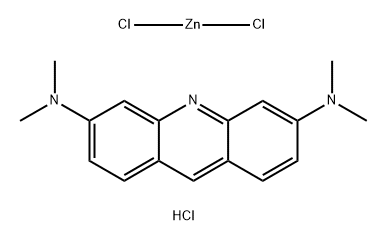| Basic Orange 14 Basic information |
| Product Name: | Basic Orange 14 |
| Synonyms: | Acridine Orange,pure,ca. 55% dye content;Acridine Orange hemi;Acridine Orange Euchrysin GNY;ACRIDINE ORANGE ZINC CHLORIDE DOUBLE SAL;CI 46005;CI NO 46005;BASIC ORANGE 14;ACRIDINE ORANGE BIOLOGICAL STAIN |
| CAS: | 10127-02-3 |
| MF: | C17H20Cl3N3Zn |
| MW: | 438.1 |
| EINECS: | 233-353-6 |
| Product Categories: | marker;Classes of Metal Compounds;Transition Metal Compounds;Zn (Zinc) Compounds |
| Mol File: | 10127-02-3.mol |
 |
| Basic Orange 14 Chemical Properties |
| Melting point | 165 °C |
| storage temp. | room temp |
| solubility | H2O: soluble1mg/mL, clear, orange to very deep orange |
| Colour Index | 46005 |
| form | Solid |
| pka | pKa -3.3(H2O T=room temperature(RT) Iunspeci?ed) (Uncertain);0.2(H2O T=room temperature(RT) Iunspeci?ed) (Uncertain);10.1(H2O T=room temperature(RT) Iunspeci?ed) (Uncertain) |
| color | Red brown |
| PH | 3.9 (10g/l, H2O, 20℃) |
| Water Solubility | soluble |
| Sensitive | Hygroscopic |
| BRN | 3734978 |
| Stability: | Stable. Incompatible with strong oxidizing agents. Protect from moisture. Hygroscopic. |
| CAS DataBase Reference | 10127-02-3(CAS DataBase Reference) |
| Safety Information |
| Hazard Codes | Xn,Xi |
| Risk Statements | 68-20/21/22-36/37/38 |
| Safety Statements | 45-36/37-36-26 |
| WGK Germany | 3 |
| RTECS | AR7600000 |
| HS Code | 32041300 |
| Toxicity | A dye used to stain nucleic acids. It fluoresces at 530 nm when intercalated into double stranded DNA, or at 640 nm when ionically bound to single stranded DNA. It produces mutations, some involving reading frame shifts, other deletions or insertions and is carcinogenic. It is also known to be a dermal phototoxicant. |
| Provider | Language |
|---|---|
| C.I. 46005 | English |
| SigmaAldrich | English |
| ACROS | English |
| ALFA | English |
| Basic Orange 14 Usage And Synthesis |
| Chemical Properties | brown powder |
| Uses | Fluorescent stain for nucleic acids. An RNA polymerase inhibitorAcridine Orange acts as a lysosomal dye. It is used for cell-cycle studies. It plays an important role as a nucleic acid-selective fluorescent cationic dye, which is useful for cell cycle determination. Further, it serves as an inhibitor of RNA polymerase. |
| Uses | Acridine Orange, a cell-permeable metachromatic fluorescent cationic dye that intercalates DNA and RNA, is used in fluorescence and epiflouresence microscopy. Acridine Orange dye has been used to analyze mitochondria and lysosomal content by flow cytometry, characterize multidrug resistance, and measure changes in mitochondrial mass during apoptosis in rat thymocytes. |
| General Description | Acridine orange is a metachromatic fluorescent cationic dye that permeates the cell membrane and intercalates DNA and RNA. It allows for visual detection of nucleic acids on agarose and polyacrylamide gels. |
| Biochem/physiol Actions | Acridine orange (AO) is a fluorescent dye with two different staining characteristics. In fixed tissues, it acts as a metachromatic dye and differentially stains DNA (green) and RNA (orange). But, in living cells it acts as a pH indicator and produce brilliant orange-red in acidic condition. AO has been used to identify apoptotic cells in drosophila embryos. Acridine Orange staining method has been used to deliver more consistent data in the micronucleus test. |
| Basic Orange 14 Preparation Products And Raw materials |
| Raw materials | 4,4′-Methylenebis(N,N-dimethylaniline) |